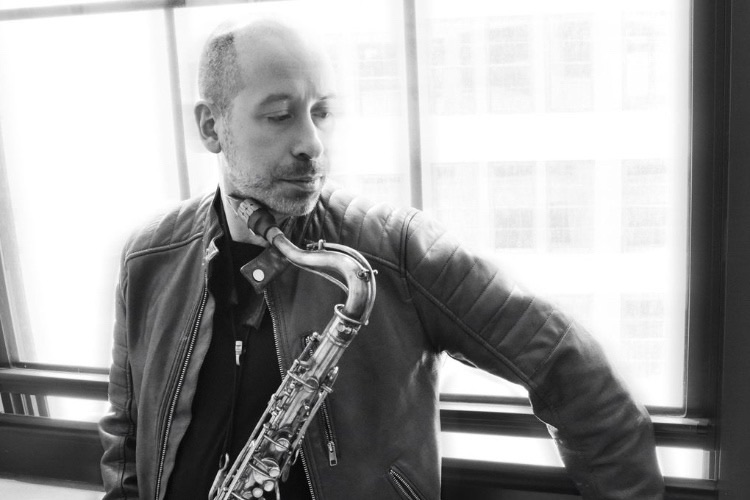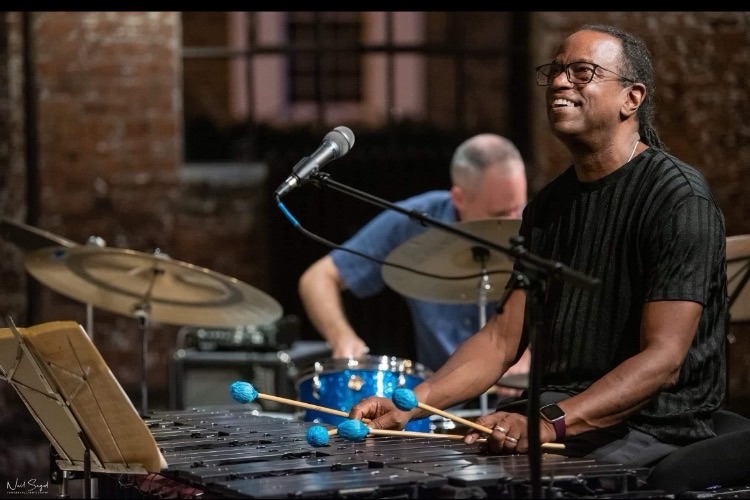Review: Ches Smith’s ‘Clone Row’
|
Getting your Trinity Audio player ready...
|
One never knows where drummer-composer Ches Smith’s muse will take him next. From the Haitian voudou of We All Break: Path of Seven Colors (Pyroclastic, 2021) to the uncategorizable mash-ups of Laugh Ash (Pyroclastic, 2024) to inventive trio albums with violist Mat Maneri and Craig Taborn to whatever else strikes his fancy, Smith is there. He has collaborated with Marc Ribot, Tim Berne, John Zorn, Bill Frisell, Nels Cline, Darius Jones, James Brandon Lewis, Vijay Iyer, and so many more that it will make your eyes glaze over. Now, the percussionist brings us Clone Row (Otherly Love, 2025), a two-guitar project featuring Mary Halvorson and Liberty Ellman with Nick Dunston on bass. While this project may, in the abstract, sound quite different from his previous work, those quirky electronic elements and unexpected twists and turns are still present, albeit with far less instrumentation than we are accustomed to. Check that, Smith made a fabulous one-guitar record with Bill Frisell joining his trio on Interpret It Well (Pyroclastic, 2022), where he primarily played vibes. Yet, this two-guitar project with Halvorson in the right channel and Ellman in the left is quite different than that one.
As Marc Ribot wrote in the album’s liner notes, “This definitely ain’t your father’s guitar band. It’s as if I’m hearing a Jim Hall concert in which one of us did a lot of mushrooms, or… some post-punk Dave Brubeck post-trip-hop experiment with classical form.” The title is a play on “tone row,” the restrictive compositional method made famous by Arnold Schoenberg. While only the title track was actually built on a twelve-tone row, the altered name fits well with Smith’s adventurous imagination. All four members of the quartet are composers. Halvorson sits atop the creative music scene in terms of guitarists. Ellman has played with the likes of Henry Threadgill, Wadada Leo Smith, Steve Coleman, Myra Melford, and Vijay Iyer. Dunston is a member of Halvorson’s Amaryllis Sextet and plays with Smith in We All Break. Ribot also attests that Dunston is his favorite bassist of the new generation.
There is more than just the two-guitar duality happening here. There are acoustic/electronic parallels with Smith using a regular kit and drum machines, Dunston using a standup bass and a synth bass, and the two rhythm mates sharing a batch of samples they use either in complementary or contrary fashion, setting up echo effects and wild dissonance. Smith calls it relatively simple, but most listeners would vehemently disagree. Each piece was built around a different concept for guitar interaction. There are unison passages, contrapuntal sequences, feisty conversations, and plain weirdness as we witness two of the most imaginative guitarists playing ‘out.’ Couple that with the leader’s zany compositional approach, which is the real star here, and you have another very unique Smith project. One where close listening reveals aspects of his eclectic previous works.
Premier Guitar says about Ellman that “his surprising choices of intervals and his penchant for evocative and unusual chords, not to mention his judicious application of overdrive and delay, he’s somewhat of an iconoclast. What’s more, his impossibly clean technique would be the envy of even the fiercest shredder.” Halvorson’s approach is best described as being built on percussive picking and her expert use of pedals – distortion and pitch shifting – and loops. Her style is primarily jagged and off-kilter, and she often uses a string-skipping technique to create unusual harmonics and textures.
Listen for the two different guitars over the bass-drum tandem steady groove of the opener “Ready Beat” with the electronics weaving in and out, sometimes functioning as a ghost-like keyboard. It may well be the most straightforward tune in the program. These ears are even hearing aspects of his Voudou drumming from We All Break, although that becomes even more apparent in “Heart Breakthrough.” The fusion-like collective interplay of ”Abrade With Me” makes use of suspended chords from both guitarists, a monstrous bass solo from Dunston, and Smith’s creative mashing of electronics with percussion. As mentioned, the title track adheres loosely to the concept of the twelve-tone row, with Smith’s vibes interacting in a friendly way with the two guitarists, who, on the other hand, seem intent on sparring with each other. However, they come together as if to reconcile toward the end, where electronics are thrown in to make such a reconciliation somewhat awkward.
More improvisation takes hold in “Town Down,” with glimpses of Halvorson’s superb guitar tone married with pedal randomness and ‘noise’ while Ellman opts more for distortion. “Heart Breakthrough,” has Smith evoking some polyrhythms we may associate with We All Break while the guitars surf above before morphing into labyrinthine journeys. “Sustained Nightmare” is the shortest piece, and as the title suggests, rubato is at play in the beginning. Smith applies an emphatic, steady beat to the tune, punctuated with electronics, dissonance, and unsettled guitar work. Closer “Play Bell (for Nick)’ is naturally a feature for the bassist without any overt solo, however, while filled with electronics, sustained guitar tones, and tons of tension.
Ches Smith proves once again that he is one of the most important visionaries of these times while displaying the talents of each member of this elite quartet.
Ches Smith’s ‘Clone Row’ will be released on Otherly Love Records on June 6, 2025. It can be purchased on Bandcamp.
Photo credit: Chase Pierson



